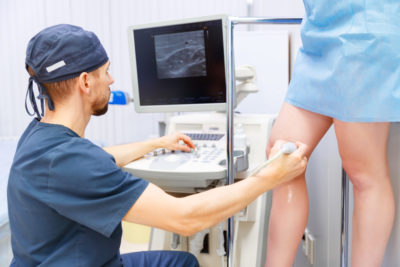What is the best treatment for varicose veins?
Treatment choices for varicose veins depend on several factors:
- Whether you are seeking treatment for cosmetic benefits.
- Whether your varicose veins are causing pain or discomfort.
- The presence of skin changes, such as ulcers, or other signs of poor circulation.
- Insurance coverage for treatment procedures.
 While in many cases, treatment choices are a matter of personal preference, there are instances where certain invasive treatment options become necessary. Vein pain in legs can be disabling and intervention is necessary. Here is an overview of some of the most common procedures used to treat varicose veins:
While in many cases, treatment choices are a matter of personal preference, there are instances where certain invasive treatment options become necessary. Vein pain in legs can be disabling and intervention is necessary. Here is an overview of some of the most common procedures used to treat varicose veins:
Sclerotherapy
There are two types of sclerotherapy depending on the severity and size of the varicosities:
- Standard sclerotherapy involves injecting a solution into the veins, which leads to scarring and closing of the specific area. Once closed, blood can no longer pool in the area, causing the veins to shrink and fade over a period of one month. In some cases, the vein must be injected more than one time for the procedure to be effective. Standard sclerotherapy can be performed in your vein specialist’s office without the need for anesthesia.
- Foam Sclerotherapy is commonly reserved for large varicosities or veins not responding to standard sclerotherapy. The procedure is very similar; however, a foam solution is used as a sealant to close the affected veins.
Laser Surgery
Laser surgery for varicose veins is considered a newer technological advancement. This procedure involves the use of lasers to emit high frequency light pulses into the affected vein. Over time, treated veins will begin to fade and eventually disappear. Treatments may need to be repeated for the best outcome. Treatment can be performed in your vein specialist’s office without anesthesia.
Catheter Assisted Radio Frequency or Laser Energy Procedures (Ablation)
This procedure uses a catheter heated by radio frequencies of laser energy to heat seal the affected vein. A small catheter is introduced into the vein, which is heated; it is then removed, which cauterizes, or seals, the varicose vein. This treatment is usually reserved for large varicosities with associated skin changes or producing pain and discomfort. The procedure is usually performed by a vein specialist certified in interventional radiology or an interventional radiologist in an outpatient setting. Although it is minimally invasive, the affected area is prepped and draped to prevent infection. A topical anesthetic is used to minimize discomfort.
Ligation and Vein Stripping
The procedure uses a series of small incisions to access the affected vein and ligate, or tie off, and remove the affected vessel. Removal of the affected areas does not affect circulation, as larger veins in the legs will pick up the slack. Vascular surgeons perform the procedure in either an outpatient surgery suite or in an operating room depending on which veins are affected. Local, regional, and general anesthesia may be used depending on risk factors and the size and severity of the affected veins.
Ambulatory Phlebectomy
Ambulatory phlebectomy is similar to vein stripping, except on a much smaller scale. The procedure is reserved for more superficial and smaller varicosities. Pieces of the affected vein are removed, utilizing small puncture sites in the skin. Local anesthesia specific to the puncture sites is used in the procedure. Minimal scarring is expected, and recovery time is generally shorter than in ligation and stripping procedures. Ambulatory phlebectomy may be performed in an outpatient surgery center or your vein specialist’s office, if equipped.
Endoscopic Vein Surgery
Endoscopic vein surgery is generally reserved for varicose veins with leg ulcers or associated circulatory symptoms. It is also used in cases unresponsive to other treatments. The procedure involves the insertion of a thin video camera in the affected area and then uses small incisions to close and remove the varicosities. The procedure is generally performed in endoscopic outpatient surgery centers under conscious sedation.
There are various options for the treatment of varicose veins depending on the severity, associated symptoms, and cosmetic benefits. Prior to discussing these options, it is important to review your health insurance options for coverage. Your vein specialist is the best person to discuss your individual cases and preference, and he or she can provide the most appropriate options for your case. Give the Vein Centre in Mt. Juliet, TN a call to discuss vein pain in your legs and let us guide you toward the best treatment path.



